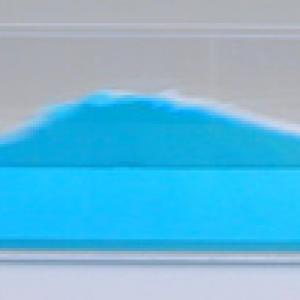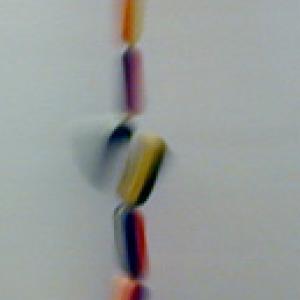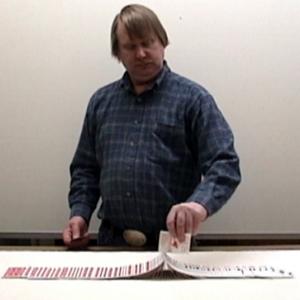College of Liberal Arts & Sciences
3B45.30 - Solitons
Fill the wave tank with about 2" to 3" of water. With the paddle give a long smooth forward stroke and the Soliton should be produced. The Soliton wave will only be good until it hits the end of the wave tank at which time many interference and reflecting waves are set up. Let the water come to a quiet state again before you can repeat the experiment.
Tipping the first block of the Jacobs Ladder toy should start a cascade wave down the length of the toy. Repeat the experiment by tipping the first block the other way.
The playing cards Soliton is fairly easy to do once the cards are spread evenly across the cloth covered board. Use a single card to lift up one end of the line of cards and the Soliton can be maintained by running the card across the top of the wave.
- Martin Gardner, "Physics Trick of the Month - A Playing-Card Soliton", TPT, Vol. 40, # 4, p. 229, April 2002.
- Antonio B. Nassar, "Build Your Own Soliton Generator", TPT, Vol. 36, # 8, p. 498- 499, Nov. 1998.
- Ron Edge, "Solitons", TPT, Vol. 36, # 8, p. 483- 485 Nov. 1998.
- Claude Laroche, Thierry Dauxois, Michel Peyrard, "Discreteness Effects on Soliton Dynamics: A Simple Experiment", AJP, Vol. 68, # 6, p. 552, June 2000.
- Erik Winkler and Junru Wu, "An Experiment to Study Localized Excitations - Nonpropagating Hydrodynamic Solitons", AJP, Vol. 58, #11, Nov. 1990, p. 1100.
- John A. Whitehead, "A Laboratory Demonstration of Solitons Using a Vertical Watery Conduit in Syrup", AJP, Vol. 55, # 11, Nov. 1987, p. 998.
- M. Olsen, H. Smith, and A. C. Scott, "Solitons in a Wave Tank", AJP, Vol. 52, #9, Sep. 1984, p. 826.
- Alessandro Bettini, Tullio A. Minelli, and Donatella Pascoli, "Solitons in Undergraduate Laboratory", AJP, Vol. 51, #11, Nov. 1983, p. 977.
- "Interacting Solitary Waves", Physics Today, Nov. 2012, p. 20.
- Jearl Walker, "2.31, Solitary Waves", The Flying Circus of Physics Ed. 2, p. 95.
- Dick Teresi, "Mysteries of Lake Champlain", How it Works - Science Supplement, Spring 2000, p. 175-181.
Disclaimer: These demonstrations are provided only for illustrative use by persons affiliated with The University of Iowa and only under the direction of a trained instructor or physicist. The University of Iowa is not responsible for demonstrations performed by those using their own equipment or who choose to use this reference material for their own purpose. The demonstrations included here are within the public domain and can be found in materials contained in libraries, bookstores, and through electronic sources. Performing all or any portion of any of these demonstrations, with or without revisions not depicted here entails inherent risks. These risks include, without limitation, bodily injury (and possibly death), including risks to health that may be temporary or permanent and that may exacerbate a pre-existing medical condition; and property loss or damage. Anyone performing any part of these demonstrations, even with revisions, knowingly and voluntarily assumes all risks associated with them.


